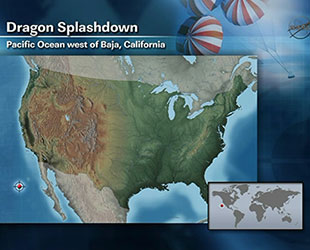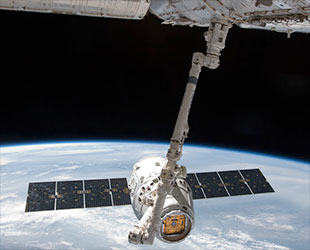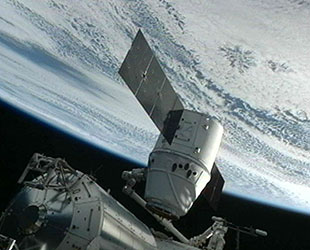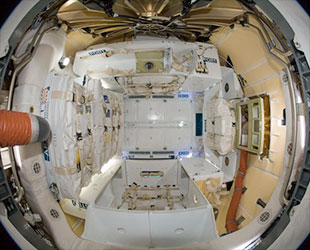May 31, 2012 — The first private spacecraft to visit the International Space Station returned to Earth on Thursday morning (May 31), creating a splash in the Pacific Ocean almost as large as the one its mission made in spaceflight history.
Space Exploration Technologies' (SpaceX) Dragon cargo capsule completed a successful 9 day test flight, landing under parachutes some 560 miles (900 kilometers) off the coast of Baja, California at 11:42 a.m. EDT (1542 GMT). A crane-equipped barge, tow boat and other support ships were reported to be making their way to the splashdown site to retrieve the unmanned spacecraft.
"Splashdown successful!!" SpaceX CEO Elon Musk wrote on Twitter. "Sending fast boat to Dragon."

NASA graphic showing the approximate location where SpaceX's Dragon spacecraft splashed down in the Pacific Ocean. (NASA) |
Launched on May 22 atop a SpaceX Falcon 9 rocket from Cape Canaveral Air Force Station, Fla., the Dragon was captured by the space station's robotic arm and berthed to the orbiting complex three days later.
The 19 foot tall (5.9 meter) by 12 foot diameter (3.7 meter) spacecraft was then emptied by the station's crew of its student science experiments and food rations before being repacked with no longer needed hardware and completed experiment equipment for the trip back to Earth.
The second test flight for the Dragon, the mission was flown under the NASA Commercial Orbital Transportation (COTS) program. With the retirement of the space shuttle last year, NASA has contracted with private companies, including SpaceX, to deliver cargo to and from the space station.
With the success of this mission, SpaceX stands poised to begin fulfilling its $1.6 billion contract to launch a dozen Dragon cargo flights later this year. Further, the company is a step closer to possibly launching NASA astronauts on Dragon as well.

With clouds over Earth forming a backdrop, the SpaceX Dragon commercial cargo capsule is grappled by the Canadarm2 robotic arm at the International Space Station on May 25, 2012. (NASA) |
Dragon's descent
The Dragon began its journey home seven hours before returning to Earth when NASA astronauts Joe Acaba and Don Pettit, working with European Space Agency (ESA) astronaut Andre Kuipers, reversed the actions they took six days before and used the space station's robotic arm to detach the capsule from the Earth-facing port on the Harmony node at 4:07 a.m. EDT (0807 GMT).
The commercial spacecraft was attached to the station for a total of 5 days, 16 hours and 5 minutes.
The ISS Expedition 31 crewmembers released the Dragon from the robotic arm's grip at 5:49 a.m. EDT (0949 GMT). Backing away from the orbiting laboratory, the free flying spacecraft fired its thrusters three times, increasing with each burn the distance between the outpost and itself.

The SpaceX Dragon commercial cargo craft is detached from the International Space Station on May 31, 2012. (NASA TV) |
With the exception of Russia's Soyuz capsules, SpaceX's Dragon is the only space station visiting vehicle now flying that can survive re-entry into the Earth's atmosphere. The Dragon's heat shield, which was developed in cooperation with NASA, is made from PICA-X, a higher performance variant of NASA's original material used to return robotic probes from deep space.
Once back in the atmosphere, the Dragon's dual drogue parachutes deployed at 45,000 feet (14 kilometers) which stabilized and slowed the spacecraft. The full deployment of the drogues triggered the three main parachutes, each 116 feet (35 meters) in diameter, at about 10,000 feet (3 kilometers).
The main parachutes further slowed the capsule's descent to approximately 11 to 12 miles per hour.
Demo delivery
The splashdown officially marked the end of the COTS-2 demonstration mission, but SpaceX has challenged itself to do more.
"We recover Dragon on to our recovery vessel, and then from there we bring it into the Port of Los Angeles. [We] then immediately transport it to our McGregor, TX facility," SpaceX mission manager John Couluris said.

"Fisheye" image of the inside of SpaceX's Dragon cargo craft as photographed by a space station crew member. (NASA) |
The capsule is packed with 1,455 pounds (660 kilograms) of cargo to be returned to NASA. SpaceX will use some of that payload to demonstrate a future requirement for the space agency.
"We have two types of cargo that we have requirements to deliver back to NASA and we're going to be demonstrating the early access cargo return, which is a pretty special return profile that wasn't normally meant for this mission," Couluris said. "That is to get high value experiments back to NASA within 48 hours of splashdown."
"That is a stretch goal for us but we are going to exercise that," he said.
The remainder of the cargo (the "standard cargo") will be delivered within two weeks.
"That we should definitely meet with the turnover occurring in McGregor, TX, which works out well for NASA because much of the payload processing will be occurring out of Johnson Space Center in Houston," Couluris said.
